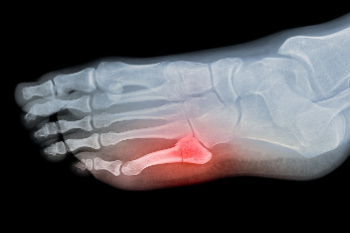(517) 487-5171
Fax (517) 908-0172
August 2024
Wounds That Don't Heal Need to Be Checked
Facts About Bunions

Bunions, characterized by a bony bump on the side of the big toe, are often caused by genetic factors, wearing ill-fitting shoes, or excessive foot pressure. The condition arises when the big toe deviates towards the second toe, leading to a misalignment at the joint. Symptoms typically include pain, swelling, and redness surrounding the affected area, along with difficulty in finding comfortable shoes. To manage bunions, it is essential to wear properly fitting shoes with ample room for the toes and avoid high heels. In cases of severe discomfort or worsening deformity, consulting a podiatrist to talk about potential surgical options may be necessary. If you have developed a bunion, it is suggested that you are under the care of this type of doctor who can guide you toward the necessary treatment methods.
If you are suffering from bunion pain, contact Dr. Gary Cesar of Michigan Foot and Ankle Center. Our doctor can provide the care you need to keep you pain-free and on your feet.
What Is a Bunion?
Bunions are painful bony bumps that usually develop on the inside of the foot at the joint of the big toe. As the deformity increases over time, it may become painful to walk and wear shoes. Women are more likely to exacerbate existing bunions since they often wear tight, narrow shoes that shift their toes together. Bunion pain can be relieved by wearing wider shoes with enough room for the toes.
Causes
- Genetics – some people inherit feet that are more prone to bunion development
- Inflammatory Conditions - rheumatoid arthritis and polio may cause bunion development
Symptoms
- Redness and inflammation
- Pain and tenderness
- Callus or corns on the bump
- Restricted motion in the big toe
In order to diagnose your bunion, your podiatrist may ask about your medical history, symptoms, and general health. Your doctor might also order an x-ray to take a closer look at your feet. Nonsurgical treatment options include orthotics, padding, icing, changes in footwear, and medication. If nonsurgical treatments don’t alleviate your bunion pain, surgery may be necessary.
If you have any questions, please feel free to contact our offices located in Lansing and Mt. Pleasant, MI . We offer the newest diagnostic and treatment technologies for all your foot care needs.
Causes and Treatment of Foot Fractures

Foot fractures can affect various bones, including the toes, metatarsals, sesamoids, and those in the back of the foot. Foot fractures are usually the result of injuries from falls, twists, or direct impacts. The pain associated with foot fractures can significantly increase when weight is applied, making everyday activities challenging. A podiatrist can provide an expert diagnosis, recommend appropriate treatment depending on the cause, and manage rehabilitation. Diagnosing foot fractures typically requires an X-ray, or may necessitate other imaging tests like CT or MRI scans for complex cases. Treatment depends on the specific bone and type of fracture, generally involving immobilization with a splint, cast, or specialized shoe to protect the foot. Patients may be advised to avoid putting weight on the foot to facilitate healing, which can take several weeks. Once the pain subsides, special exercises may be recommended to restore mobility and strengthen the surrounding muscles. If you have fractured a bone in your foot, it is suggested that you schedule an appointment with a podiatrist for a diagnosis and treatment.
A broken foot requires immediate medical attention and treatment. If you need your feet checked, contact Dr. Gary Cesar from Michigan Foot and Ankle Center. Our doctor can provide the care you need to keep you pain-free and on your feet.
Broken Foot Causes, Symptoms, and Treatment
A broken foot is caused by one of the bones in the foot typically breaking when bended, crushed, or stretched beyond its natural capabilities. Usually the location of the fracture indicates how the break occurred, whether it was through an object, fall, or any other type of injury.
Common Symptoms of Broken Feet:
- Bruising
- Pain
- Redness
- Swelling
- Blue in color
- Numbness
- Cold
- Misshapen
- Cuts
- Deformities
Those that suspect they have a broken foot shoot seek urgent medical attention where a medical professional could diagnose the severity.
Treatment for broken bones varies depending on the cause, severity and location. Some will require the use of splints, casts or crutches while others could even involve surgery to repair the broken bones. Personal care includes the use of ice and keeping the foot stabilized and elevated.
If you have any questions please feel free to contact our offices located in Lansing and Mt. Pleasant, MI . We offer the newest diagnostic and treatment technologies for all your foot and ankle needs.
Common Foot Injuries From Pickleball

As pickleball gains popularity across the nation, foot and ankle injuries are becoming more common among players. The fast-paced, lateral movements and sudden stops required in pickleball often lead to strains, sprains, and fractures. Ankle sprains are frequent due to the rapid direction changes, while plantar fasciitis can develop from the repetitive stress on the feet. Achilles tendonitis is another concern, especially for older players, as the sport's dynamic movements can overburden this tendon at the back of the heel. Despite pickleball being a low-impact sport, the risk of injury to players remains significant. Regularly stretching and warming up before playing can help to avoid injuries, but seeing a podiatrist is essential for those experiencing foot pain. A podiatrist can diagnose and treat foot and ankle injuries, recommend proper footwear, and provide strategies to prevent future problems. If you have foot or ankle pain connected to playing pickleball, it is suggested that you schedule an appointment with a podiatrist.
Ankle and foot injuries are common among athletes and in many sports. They can be caused by several problems and may be potentially serious. If you are feeling pain or think you were injured in a sporting event or when exercising, consult with Dr. Gary Cesar from Michigan Foot and Ankle Center. Our doctor will assess your condition and provide you with quality foot and ankle treatment.
Common Injuries
The most common injuries that occur in sporting activities include:
- Achilles Tendonitis
- Achilles Tendon Rupture
- Ankle Sprains
- Broken Foot
- Plantar Fasciitis
- Stress Fractures
- Turf Toe
Symptoms
Symptoms vary depending upon the injury and in some cases, there may be no symptoms at all. However, in most cases, some form of symptom is experienced. Pain, aching, burning, bruising, tenderness, tightness or stiffness, sensation loss, difficulty moving, and swelling are the most common symptoms.
Treatment
Just as symptoms vary depending upon the injury, so do treatment options. A common treatment method is known as the RICE method. This method involves rest, applying ice, compression and elevating the afflicted foot or ankle. If the injury appears to be more serious, surgery might be required, such as arthroscopic or reconstructive surgery. Lastly, rehabilitation or therapy might be needed to gain full functionality in the afflicted area. Any discomfort experienced by an athlete must be evaluated by a licensed, reputable medical professional.
If you have any questions, please feel free to contact our offices located in Lansing and Mt. Pleasant, MI . We offer the newest diagnostic and treatment technologies for all your foot care needs.
Strengthening Exercises for Flat Feet

Flat feet, characterized by low or absent arches, can lead to foot pain and discomfort if not properly managed. Strengthening exercises can help to alleviate symptoms and improve foot function. Toe curls are effective in strengthening the muscles that support the arch, and simply curling a towel with your toes can achieve this. Arch lifts involve standing on your toes and slowly lowering back down, repeating several times to build strength in the arch area. Heel raises also target the calf muscles, essential for supporting the foot's structure. Additionally, toe spreads can help strengthen the muscles between the toes, enhancing overall foot stability. Consistency is key to seeing results, so incorporating these exercises into a daily routine, in addition to wearing supportive footwear, can significantly benefit individuals with flat feet. If you have flat feet, it is suggested that you consult a podiatrist who can offer you effective relief techniques for any pain or discomfort you may have.
Flatfoot is a condition many people suffer from. If you have flat feet, contact Dr. Gary Cesar from Michigan Foot and Ankle Center. Our doctor will treat your foot and ankle needs.
What Are Flat Feet?
Flatfoot is a condition in which the arch of the foot is depressed and the sole of the foot is almost completely in contact with the ground. About 20-30% of the population generally has flat feet because their arches never formed during growth.
Conditions & Problems:
Having flat feet makes it difficult to run or walk because of the stress placed on the ankles.
Alignment – The general alignment of your legs can be disrupted, because the ankles move inward which can cause major discomfort.
Knees – If you have complications with your knees, flat feet can be a contributor to arthritis in that area.
Symptoms
- Pain around the heel or arch area
- Trouble standing on the tip toe
- Swelling around the inside of the ankle
- Flat look to one or both feet
- Having your shoes feel uneven when worn
Treatment
If you are experiencing pain and stress on the foot you may weaken the posterior tibial tendon, which runs around the inside of the ankle.
If you have any questions please feel free to contact our offices located in Lansing and Mt. Pleasant, MI . We offer the newest diagnostic and treatment technologies for all your foot and ankle needs.









